

Appium Bootcamp – Chapter 7: Automate Your Tests. To make our tests as useful as possible, we’ll want to automate when they get run.
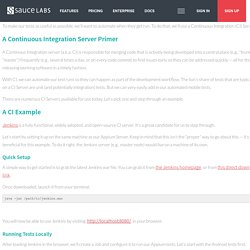
To do that, we’ll use a Continuous Integration (CI) Server. A Continuous Integration Server Primer A Continous Integration server (a.k.a. CI) is responsible for merging code that is actively being developed into a central place (e.g., “trunk” or “master”) frequently (e.g., several times a day, or on every code commit) to find issues early so they can be addressed quickly — all for the sake of releasing working software in a timely fashion. With CI, we can automate our test runs so they can happen as part of the development workflow.
Static Analysis on iOS - Part II - Ruenzuo.io. This is the second part of my post about static analysis setup on iOS for test results and code coverage, PMD analysis, duplicate code trends and source lines of code count metrics.

For this part, I'll be referencing this repository. If you're interested in what are those metrics or what are the motivations behind this, be sure to check the first part of this post. The following assumes that you have basic knowledge about Jenkins CI and Linux Shell scripting. Build system We'll be using xctool as our build system for this. So, to setup xctool with your project, you will need to install the script on your computer and add a .xctool-args file on your repository. Test results and Code coverage. Introduction. This document describes how to use the HeaderDoc tool.

It also explains how to insert HeaderDoc comments into your headers and other files. This document corresponds with HeaderDoc 8.0. For information about previous versions, consult the documentation installed with your HeaderDoc distribution. What is HeaderDoc? HeaderDoc is a set of tools for embedding structured comments in source code and header files written in various languages and subsequently producing rich HTML and XML output from those comments. HeaderDoc is primarily intended for use on OS X, as part of the OS X Developer Tools. In addition to traditional HeaderDoc markup, HeaderDoc 8 supports JavaDoc markup.
AppleScriptBourne shell (and Korn and Bourne Again)C Headers and C source codeC++ headersC shell scriptsJavaJavaScriptMach MIG definitionsObjective C/C++ headersPascalPerlPythonPHPRubyTcl Both scripts are typically installed in /usr/bin, as headerdoc2html and gatherheaderdoc. How Do I Get It? Organization of This Document. Ios - Problems with sloccount on OSX Mavericks. iOS dev: How to setup quality metrics on your Jenkins job? iOS development projects are not first-in-class when it comes to managing the quality of the software produced.
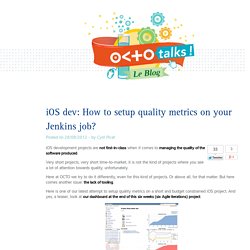
Very short projects, very short time-to-market, it is not the kind of projects where you see a lot of attention towards quality, unfortunately. Here at OCTO we try to do it differently, even for this kind of projects. Or above all, for that matter. But here comes another issue: the lack of tooling. How to Set Up Customized Jenkins for iOS. Today we will learn how to setup a Continuous Integration (CI) environment for iOS projects using Jenkins.
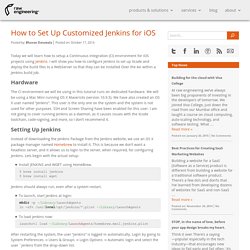
I will show you how to configure Jenkins to set up Xcode and deploy the build files to a WebServer so that they can be installed Over the Air within a Jenkins build job. Hardware The CI environment we will be using in this tutorial runs on dedicated hardware. We will be using a Mac Mini running OS X Mavericks (version 10.9.5). We have also created an OS X user named “jenkins”. Setting Up Jenkins Instead of downloading the Jenkins Package from the Jenkins website, we use an OS X package manager named Homebrew to install it. Install JENKINS and WGET using HomeBrew. Adopting Modern Objective-C. Over the years, the Objective-C language has grown and evolved.
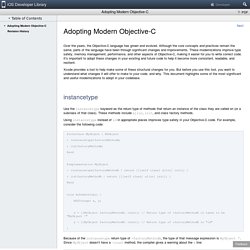
Although the core concepts and practices remain the same, parts of the language have been through significant changes and improvements. These modernizations improve type safety, memory management, performance, and other aspects of Objective-C, making it easier for you to write correct code. It’s important to adopt these changes in your existing and future code to help it become more consistent, readable, and resilient. Xcode provides a tool to help make some of these structural changes for you. But before you use this tool, you want to understand what changes it will offer to make to your code, and why. Instancetype Use the instancetype keyword as the return type of methods that return an instance of the class they are called on (or a subclass of that class). Qualité & Industrialisation des développements mobiles sur iOS & Andr…
Mise en place d’un plateforme d’intégration IOS avec Jenkins sous Mac OSX 10.8 / XCode 5. Ce post de blog détaille : Comment installer les outils coté serveurComment configurer un projet pour qu’il soit correctement pris en charge.
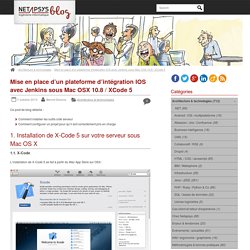
Tutoriel: Documenter un code avec Doxygen. Introduction à Doxygen A l'instar de Javadoc, Doxygen est un lgociel libre de documentation de code possédant des capacités de génération de documentation à partir du code source d'un programme.
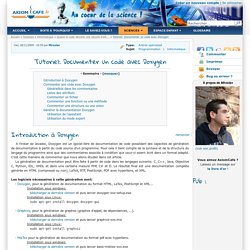
Pour cela il tient compte de la syntaxe et de la structure du langage du programme ainsi que des commentaires associés à condition que ceux-ci soient écrit dans un format adapté. C'est cette manière de commenter que nous allons étudier dans cet article. La génération de documentation peut être faite à partir de code dans les langages suivants: C, C++, Java, Objective C, Python, IDL, VHDL et dans une certaine mesure PHP, C# et D. Le résultat final est une documentation complète générée en HTML (compressé ou non), LaTeX, RTF, PostScript, PDF avec hyperliens, et XML.
Les logiciels nécessaires à cette génération sont: - Doxygen, pour la génération de documentation au format HTML, LaTex, PostScript et XML... Installation sous windows: sudo apt-get install doxygen doxygen-gui Installation sous Linux: